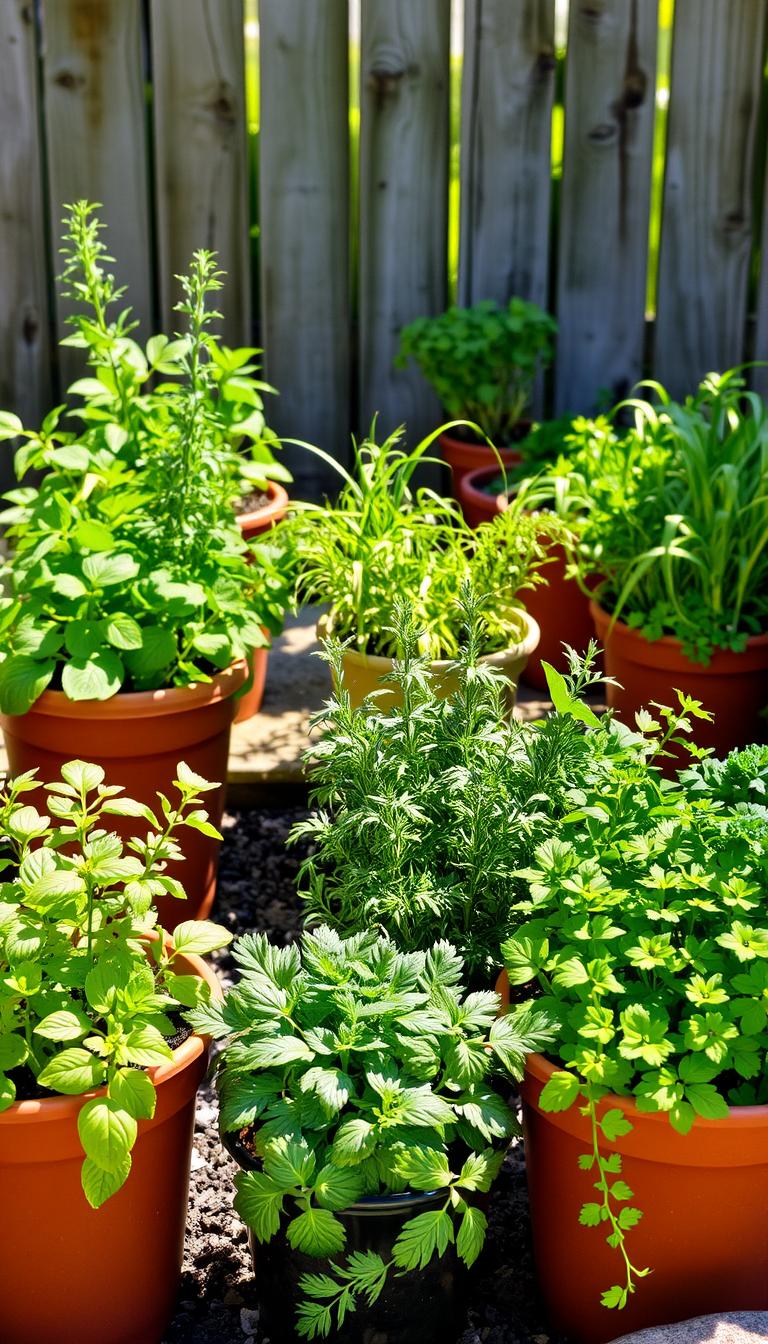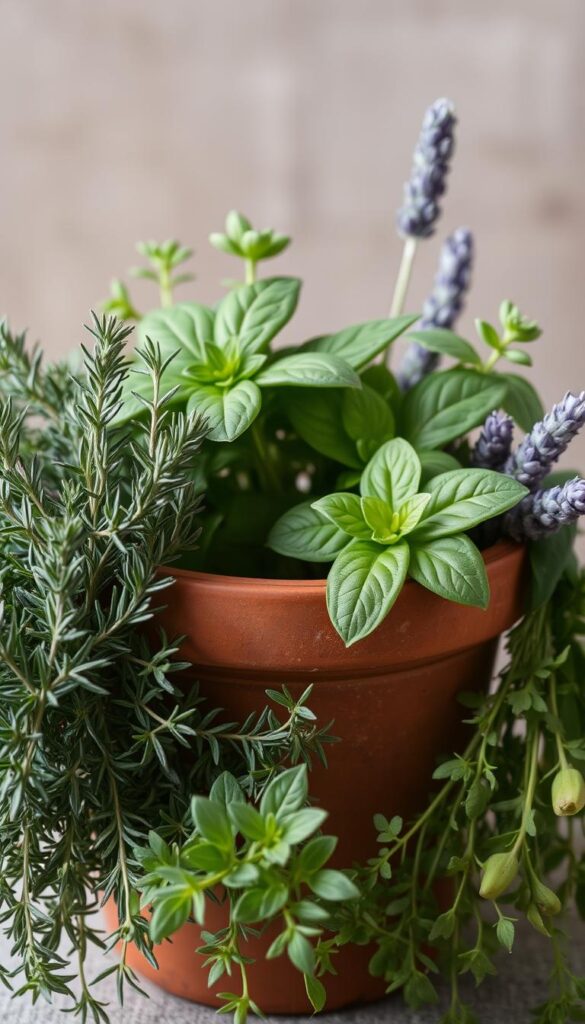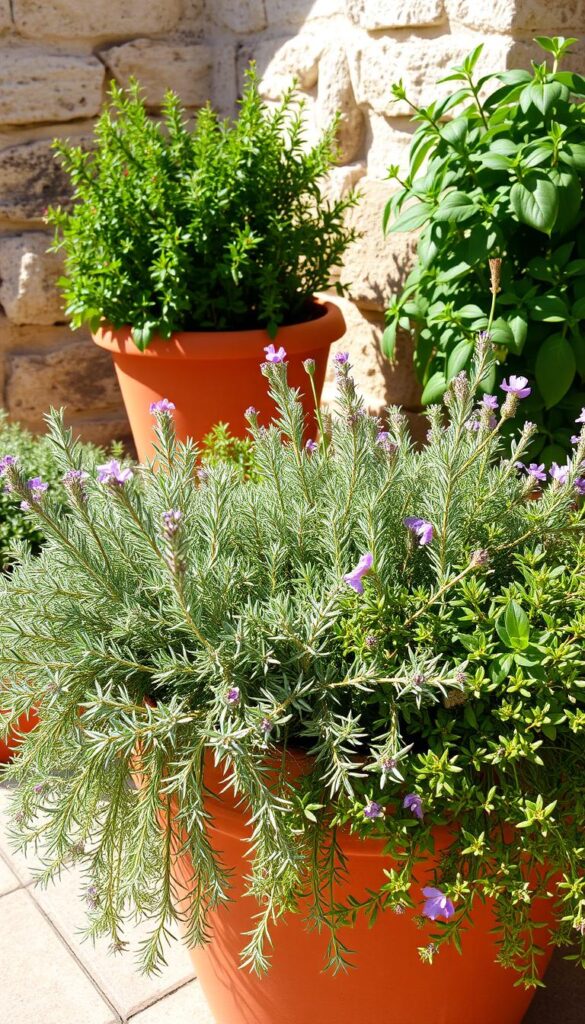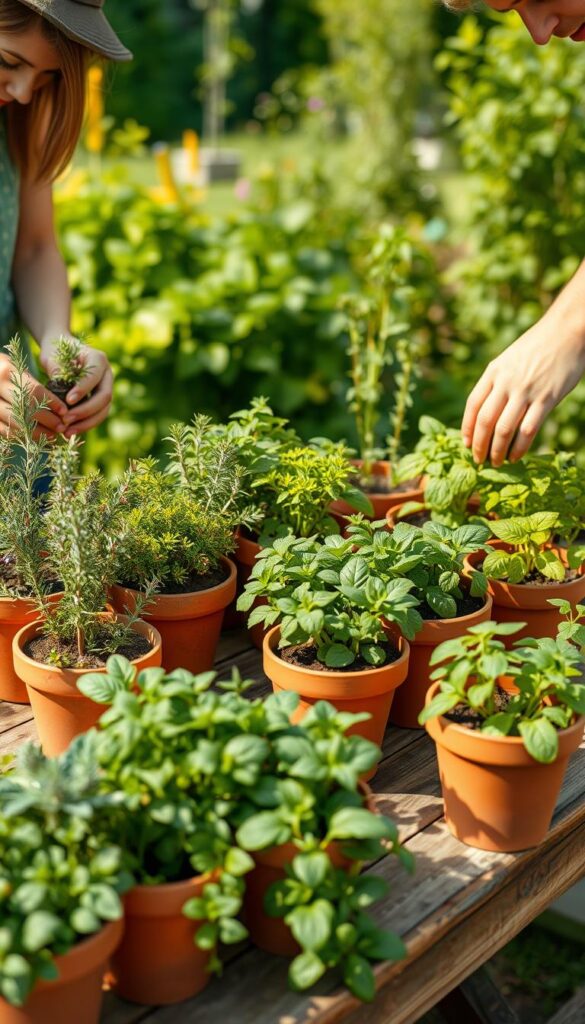
Best Herb Pairings To Grow Together In Pots
Imagine growing a thriving herb garden in just one pot—without the guesswork. The right herb pairings can turn your container into a flavor-packed, low-maintenance oasis. But how do you know which herbs actually thrive together?
This guide reveals the science behind herb garden ideas that work. Learn why certain herbs boost each other’s growth while others clash, leaving you with sickly plants. From rosemary to cilantro, we’ll show you container gardening herbs that play nice—and those that need space.
Whether you’re a first-time gardener or a seasoned pro, this article breaks down the secrets to pairing herbs that share water, sunlight, and soil preferences. No more trial and error—just proven combinations for fresh flavors and lush greenery all season long.
Why Growing Multiple Herbs Together Makes Sense
Gardening in tight spaces doesn’t mean you have to give up variety. Companion planting herbs is a great solution for every gardener. Whether you have a balcony or a windowsill, grouping herbs wisely saves space, boosts health, and increases harvests without overcrowding.
Space-Saving Benefits for Urban Gardeners
City dwellers love indoor herb garden setups. Mixing herbs like basil and chives in containers leads to layered growth. Tall herbs like cilantro grow upright, while spreading ones like thyme fill in gaps. A 12-inch pot can hold three herbs, making small spaces productive herb garden ideas.
Complementary Growth Patterns
Some herbs naturally help each other. Try:
- Basil + Parsley: Basil keeps aphids away, and parsley adds texture.
- Chives + Mint: Chives keep carrot flies off, and mint’s runners stay in pots.
Natural Pest Management Between Herbs
Pairing scented herbs like rosemary and sage with delicate ones like cilantro creates a natural barrier. Their strong smells confuse pests. A study by the National Garden Bureau shows companion planting herbs can cut pest issues by 40% without using chemicals.
| Herb Pair | Space Benefit | Pest Control |
|---|---|---|
| Rosemary + Thyme | Vertical + ground cover combo | Repels cabbage moths |
| Parsley + Dill | Layered foliage heights | Deters spider mites |
Even small indoor herb garden setups benefit from these principles. Mix and match herbs to create living, edible ecosystems that fit any space.
Understanding Herb Compatibility Basics
Successful herbs that grow well together need to match their basic needs. Group plants by their water needs. For example, drought-loving herbs like rosemary and thyme do well together. On the other hand, basil and parsley, which need more moisture, also pair well.
Companion planting herbs also depends on sunlight. Full-sun herbs like sage and oregano need to be together. Meanwhile, mint and chives, which prefer shade, can live together in partial light.

- Root Depth: Shallow-rooted herbs (thyme, chives) go well with deeper-rooted rosemary to avoid competition.
- Growth Speed: Fast growers like cilantro shouldn’t crowd slower rosemary or lavender.
- Family Ties: Alliums (chives, garlic chives) often complement non-allium herbs, but avoid pairing tomatoes with sage (both nightshade family members).)
| Herb Pair | Water | Sunlight | Notes |
|---|---|---|---|
| Basil + Parsley | Moderate, consistent | 6–8 hours sun | Both prefer moist soil but tolerate some shade |
| Rosemary + Sage | Infrequent watering | Full sun | Excellent companion planting herbs for dry climates |
| Mint + Lemon Balm | Regular watering | Partial shade | Both spread aggressively—plant in separate pots to avoid competition |
When pairing herb combinations for pots, balance is key. Don’t mix mint with slow-growing herbs unless you use barriers. Focus on shared preferences to create thriving spaces in small areas.
Mediterranean Herb Combinations That Thrive Together
Mediterranean herbs are great for best herb pairings to grow together in pots. They love sun and dry soil, making them perfect for container gardening herbs. These plants create beautiful and flavorful herb potting combinations.

The Classic Rosemary, Thyme and Sage Trio
Rosemary grows tall, adding height. Thyme spreads, keeping weeds away. Sage fills in the middle with soft leaves. Together, they make a balanced mix.
- Rosemary: Tall stems add height
- Thyme: Creeping habit covers soil
- Sage: Bushy leaves fill gaps
Adding Oregano to the Mix
Adding oregano boosts culinary use. Its small size fits well between taller herbs. Use it fresh in pasta or dried for seasoning. It adds taste and texture.
Water and Sunlight Requirements
These herbs need 6-8 hours of full sun daily. Water deeply but infrequently—wait until soil is dry 1″ deep before rewatering. Use terracotta pots with drainage holes to mimic their native rocky soils. Containers should be at least 12″ wide to accommodate roots.
Best Herb Pairings To Grow Together In Pots for Culinary Excellence
Transform your patio into a flavor lab with herb combinations for pots perfect for your favorite dishes. These herb garden ideas bring top-notch ingredients right to your kitchen. Whether you’re whipping up pasta, stir-fries, or herbal teas, you’ll have what you need.
With mixed herb planting techniques, you can blend flavors while meeting each plant’s needs. This way, your garden is both tasty and well-cared for.

Italian Cuisine Inspired Pairings
Bring Mediterranean classics to life with basil, oregano, and parsley. Basil likes shade, but these three do well together in a sunny spot with some afternoon shade. Choose a deep pot for parsley, as it has long roots.
Harvest basil leaves often to keep it bushy. This is great for making pesto and tomato dishes.
Asian Flavors Collection
For sushi and curries, mix cilantro, Thai basil, and lemongrass in wide, shallow containers. These moisture-loving herbs do well in clay pots to keep humidity up. Prune Thai basil often to stop it from flowering.
This ensures strong flavors for stir-fries and soups.
Herbs for Tea and Beverage Gardens
Blend mint, lemon balm, and chamomile in hanging baskets or window boxes. Use well-draining soil to avoid root rot. These herbs love consistent watering.
Pluck young leaves for teas, and let a few flowers bloom to attract pollinators. Pair with lavender for floral notes in iced teas.
Mint Family Companions: Who Gets Along With Whom
When it comes to container gardening herbs from the mint family (Lamiaceae), growth habits matter most. Peppermint and spearmint spread aggressively, crowding out smaller plants. They do best alone in pots or with plants like lemon balm or catnip.

Basil and oregano, less invasive than mints, get along well. Pairing herbs that grow well together like sweet basil and Italian oregano creates tasty combos. They both like similar sun and water, making them great container friends.
- Good pairings: Basil + oregano, thyme + sage
- Avoid: Planting mints near slow-growing rosemary or lavender
Use barriers like porous dividers in pots to stop mints from spreading. Grow mints in deep containers with heavy soil to control their growth. Regularly harvest basil and oregano to prevent overcrowding.
For small spaces, try a trio of compact oregano, marjoram, and chives in a window box. Watch the soil moisture closely—some Lamiaceae like it drier than others. Adjust spacing and watering to keep these aromatic neighbors happy in shared containers.
Balancing Herbs with Different Growth Habits
To make a lively mixed herb garden, mix plants with different growth patterns. Start by layering tall and trailing herbs. This way, you use space well and make your garden look great.
Pairing Tall and Trailing Herbs
Match upright herbs like dill or fennel with spreading ones like creeping thyme or prostrate rosemary. This vertical approach adds depth and looks like a natural setting.
- Tall herbs: Provide vertical structure (basil, rosemary)
- Trailing herbs: Spill over edges (oregano, mint)
Managing Aggressive Spreaders
Mint and lemon balm need to be kept in check to stop them from taking over. Here are some tips for growing herbs together:
- Plant aggressive growers in buried pots within larger containers
- Trim runners monthly to control spread
- Pair with sturdy herbs like rosemary to balance growth energy
Creating Visual Interest with Textures
Mix different leaf shapes and colors to make your garden come alive. Try:
- Dill’s lacy foliage with sage’s velvety leaves
- Silvery lavender paired with bright green basil
- Contrast chervil (feathery) with parsley (rounded)
These combinations make your herb garden visually appealing. They also ensure that all the plants get the right amount of light and water.
Container Selection for Successful Herb Combinations
Choosing the right container is crucial for container gardening herbs. Different materials like terracotta, ceramic, plastic, and fabric have their own advantages. Terracotta is great for herbs like rosemary because it dries quickly.
Ceramic pots keep moisture in longer, which is perfect for basil or mint. Plastic pots are light and easy on the wallet. Fabric pots help with root health by improving airflow.
| Material | Pros | Cons | Best For |
|---|---|---|---|
| Terracotta | Absorbs excess moisture | Dries fast in sun | Rosemary, thyme |
| Ceramic | Stylish and durable | Heavy | Basil, parsley |
| Plastic | Lightweight and affordable | Less insulating | Mint, chives |
| Fabric | Self-draining fabric | Less sturdy | Indoor herb garden setups |
Make sure your pots have drainage holes. Add gravel or pot feet to avoid waterlogging. For herb potting combinations with deep roots like parsley, use 8-inch deep containers.
Compact herbs like thyme do well in shallow 4-6″ pots. For indoor gardens, consider self-watering containers and saucers to protect floors. Get creative with items like colanders or hanging baskets for your indoor herb garden.
Add casters to large pots for easy movement. This helps with sun rotation or winter protection. Match your container’s size and material to your herbs’ needs for a successful garden.
Soil and Fertilizer Needs for Mixed Herb Pots
For container gardening herbs to thrive, the soil must balance drainage and nutrients. Start by making a mix that suits your herb combinations for pots. For example, Mediterranean herbs like rosemary and thyme need soil that drains well to prevent root rot. Mix 1 part sand with 2 parts potting soil for these herbs.
Creating the Ideal Soil Mix
- Basil and parsley do well in richer soil. Mix 1 part compost with 1 part perlite and 2 parts peat moss.
- Use coco coir as a base to keep moisture in for delicate herbs like cilantro.
- Make sure pots have drainage holes to prevent waterlogging.
Fertilizing Schedules That Work for Everyone
Feed best herb pairings to grow together in pots with half-strength balanced fertilizer (like 10-10-10 NPK) every 4-6 weeks during growing season. Avoid high-nitrogen blends that can reduce flavor. For organic options, try seaweed extract or worm castings applied biweekly.
pH Considerations for Different Herb Groupings
Test soil pH yearly using a home kit. Adjust levels gradually:
- Rosemary and thyme prefer 6.0–6.5 pH
- Basil and chives thrive at 6.0–7.0 pH
- Lavender requires alkaline soil between 6.5–7.0
Amend soil with lime to raise pH or sulfur to lower it, following package instructions. Keeping the right pH ensures all herbs in mixed containers get the nutrients they need.
Troubleshooting Common Issues in Mixed Herb Containers
Even the best container gardening herbs can run into problems. Catching issues early helps your plants stay healthy. Let’s look at common problems and how to solve them.
| Problem | Signs | Solution |
|---|---|---|
| Overgrowth dominance | One plant overshadows others | Trim aggressively spreading herbs like mint. Repot incompatible plants separately. |
| Water imbalance | Wilting, yellow leaves, root rot | Check soil moisture daily. Use pots with drainage. Adjust watering schedules for drought-tolerant herbs like rosemary. |
| Pests/disease | Yellow spots, sticky residue, leaf drop | Neem oil sprays for aphids. Remove infected leaves. Ensure airflow between plants. |
For indoor herb garden struggles:
- Low light? Move containers to sunnier windows or use grow lights.
- Leggy stems? Rotate pots weekly for even light exposure.
- Humidity issues? Mist herbs like basil or place pots on pebble trays.
Prevent problems by checking growth weekly. Adjust spacing and water as needed. For herb garden ideas, pair herbs with similar needs to reduce stress. Regular checks keep your container garden vibrant and productive.
Seasonal Adjustments for Year-Round Herb Gardens
Herb garden ideas for containers must change with the seasons to keep plants healthy. Adjusting care routines helps herb combinations for pots thrive all year. Use these tips to extend your garden’s growing season:
| Season | Action | Herb Suggestions |
|---|---|---|
| Fall | Prune, reduce water | Thyme, sage |
| Winter | Insulate or move indoors | Rosemary, bay leaf |
| Spring | Refresh soil, prune | Basil, parsley |
Transitioning Your Herb Pots from Summer to Fall
Cut back leggy growth by 1/3 in autumn. Water less frequently as daylight fades. Replace summer herbs like basil with cold-tolerant choices like chives or oregano. Group pots under eaves to shelter from frost.
Winter Protection Strategies
- Wrap containers in burlap for extra insulation
- Shift frost-sensitive pots to a garage or sunny windowsill for indoor herb garden use
- Trim dead leaves but avoid heavy pruning until spring
Spring Rejuvenation Tips
Scrape off old soil surface and top with compost. Replace any herbs that didn’t survive winter. Try new herb combinations for pots like dill and cilantro for spring growth. Gradually reintroduce outdoor pots to full sun over a week.
Transform Your Kitchen and Patio with Your Own Herb Pairings Garden
Now it’s time to make your herb garden a reality. Start with a small pot of basil and parsley on your windowsill. Or, try a balcony container with rosemary, thyme, and oregano for fresh flavors all year.
Find the perfect pairings for your favorite dishes. For Asian meals, mix cilantro and lemongrass in a shaded spot. For floral teas, combine lavender and lemon balm. Keep track of what works and what doesn’t to improve your pairings.
As you garden, let your creativity grow. Try growing new herbs from cuttings or saving seeds. Rotate your herbs with the seasons to keep your space lively. Every pot in your garden tells a story of discovery and growth.
Leave a Reply